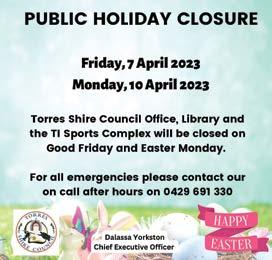
3 minute read
Being
with communities to get better results.”
She said every level of government needed to redouble its efforts to improve outcomes for First Nations peoples across the range of targets.
The latest data follows last month’s release of the 2023 Closing the Gap Implementation Plan
“The Closing the Gap Implementation Plan, launched last month, sets a clear path forward for how we plan to achieve the targets and priority reforms set out in the National Agreement on Closing the Gap,” she said.
“We will continue to work in partnership with the Coalition of Peaks and state and territory governments and eventually a Voice to address these results.”
New measures in the 2023 Implementation Plan include:
• $150 million over four years to support First Nations water infrastructure and provide safe and reliable water for remote and regional Indigenous communities through the National Water Grid Fund. This will be targeted at communities that currently do not have access to clean drinking water.
• $111.7 million Commonwealth contribution to a new one-year partnership with the Northern Territory Government to accelerate building of new remote housing, targeted at addressing the worst over-crowding.
The month of April is Sexually Transmissible Infections (STI) Awareness Month Torres and Cape Hospital and Health Service (TCHHS) Men’s and Women’s Health Clinical Coordinator Sandra Gregson says.
“This is an opportunity for Cape York, Torres Strait, and Northern Peninsula Area residents to consider their risks and take appropriate precautions,” she said.
“The rate of sexually transmissible infections (STIs) including chlamydia, gonorrhoea and syphilis has climbed state-wide and nationally over the past 20 years.
“Notifications of infectious syphilis – three cases to date – in the TCHHS are on a par with previous year to date numbers.
“However, we have seen increases in notifications of chlamydia (217 cases this year to date compared to 103 for the same period last year) and gonorrhoea – 69 cases to date compared to 30 for the same period last year – similar to the state-wide and national increases in notifications.
• $11.8 million over two years for the National Strategy for Food Security in remote First Nations communities. This is about making essential food more affordable and accessible in remote communities.
The plan highlighted the importance of formal partnerships with Aboriginal and Torres Strait Islander communities and organisations.
Nine targets updated in March 2023
Targets not on track
• Target 2 – By 2031, increase the proportion of Aboriginal and Torres Strait Islander babies with a healthy birthweight to 91 per cent, is improving, but not on track.
• Target 5 – By 2031, increase the proportion of Aboriginal and Torres Strait Islander people (age 20-24) attaining year 12 or equivalent qualification to 96 per cent, is improving, but not on track.
• Target 6 – By 2031, increase the proportion of Aboriginal and Torres
“As elsewhere in Queensland and nationally, this is thought to be partly attributed to advances in diagnostic technology and increased testing.
“But it is also linked to increases in the use of dating apps and greater access to more sexual partners.
“The best way to prevent getting an STI is to use condoms with waterbased lubricant.
“Condoms, if used correctly, are the most effective way to reduce the risk of contracting an STI whilst also helping to prevent pregnancy.
“Having regular sexual health checks is another important part of maintaining good sexual health.
“Many STIs do not have symptoms, so the only way to know if you have an STI is to have a sexual health check, including STI testing.
“For most sexually active people, it is recommended to get tested at least once a year, but there are situations where getting tested more regularly is advised.”
See: https://www.qld.gov.au/health/ staying-healthy/sexual-health/sti
Strait Islander people aged 25-34 years who have completed a tertiary qualification (Certificate III and above) to 70 per cent, is improving, but not on track.
• Target 7 – By 2031, increase the proportion of Aboriginal and Torres Strait Islander youth (15-24 years) who are in employment, education or training to 67 per cent, is improving, but not on track


• Target 9A – By 2031, increase the proportion of Aboriginal and Torres Strait Islander people living in appropriately sized (not overcrowded) housing to 88 per cent, is improving, but not on track.
• Target 14 –Significant and sustained reduction in suicide of Aboriginal and Torres Strait Islander people towards zero, is not on track and worsening.


• Target 15B - By 2030, a 15 per cent increase in sea covered by, Aboriginal and Torres Strait Islander people’s legal rights or interests, is improving, but not on track.
Targets on track
• Target 8 - By
2031, increase the proportion of Aboriginal and Torres Strait Islander people aged 25-64 who are employed to 62 per cent, is improving and on track.
• Target 15A - By 2030, a 15 per cent increase in land mass subject to Aboriginal and Torres Strait Islander people’s legal rights or interests, is improving and on track






